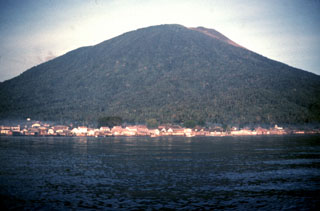Report on Gamalama (Indonesia) — July 1989
Scientific Event Alert Network Bulletin, vol. 14, no. 7 (July 1989)
Managing Editor: Lindsay McClelland.
Gamalama (Indonesia) Gas emission; crater wall collapse; tremor
Please cite this report as:
Global Volcanism Program, 1989. Report on Gamalama (Indonesia) (McClelland, L., ed.). Scientific Event Alert Network Bulletin, 14:7. Smithsonian Institution. https://doi.org/10.5479/si.GVP.SEAN198907-268060
Gamalama
Indonesia
0.81°N, 127.3322°E; summit elev. 1714 m
All times are local (unless otherwise noted)
Weak white fumes rose 150-300 m above the crater in late July. Collapse and sliding of the crater walls caused extension of the crater toward the NW and E. Fumarole temperatures at the volcano's summit were 82-90°C. On 28 and 29 July, volcanic tremor episodes with amplitudes of 0.5 mm were recorded for 11 and 16 minutes. Volcanic (16), distant tectonic (420), and local tectonic (10) earthquakes were recorded.
Geological Summary. Gamalama is a near-conical stratovolcano that comprises the entire island of Ternate off the western coast of Halmahera, and is one of Indonesia's most active volcanoes. The island was a major regional center in the Portuguese and Dutch spice trade for several centuries, which contributed to the extensive documentation of activity. Three cones, progressively younger to the north, form the summit. Several maars and vents define a rift zone, parallel to the Halmahera island arc, that cuts the volcano; the S-flank Ngade maar formed after about 14,500–13,000 cal. BP (Faral et al., 2022). Eruptions, recorded frequently since the 16th century, typically originated from the summit craters, although flank eruptions have occurred in 1763, 1770, 1775, and 1962-63.
Information Contacts: VSI.

